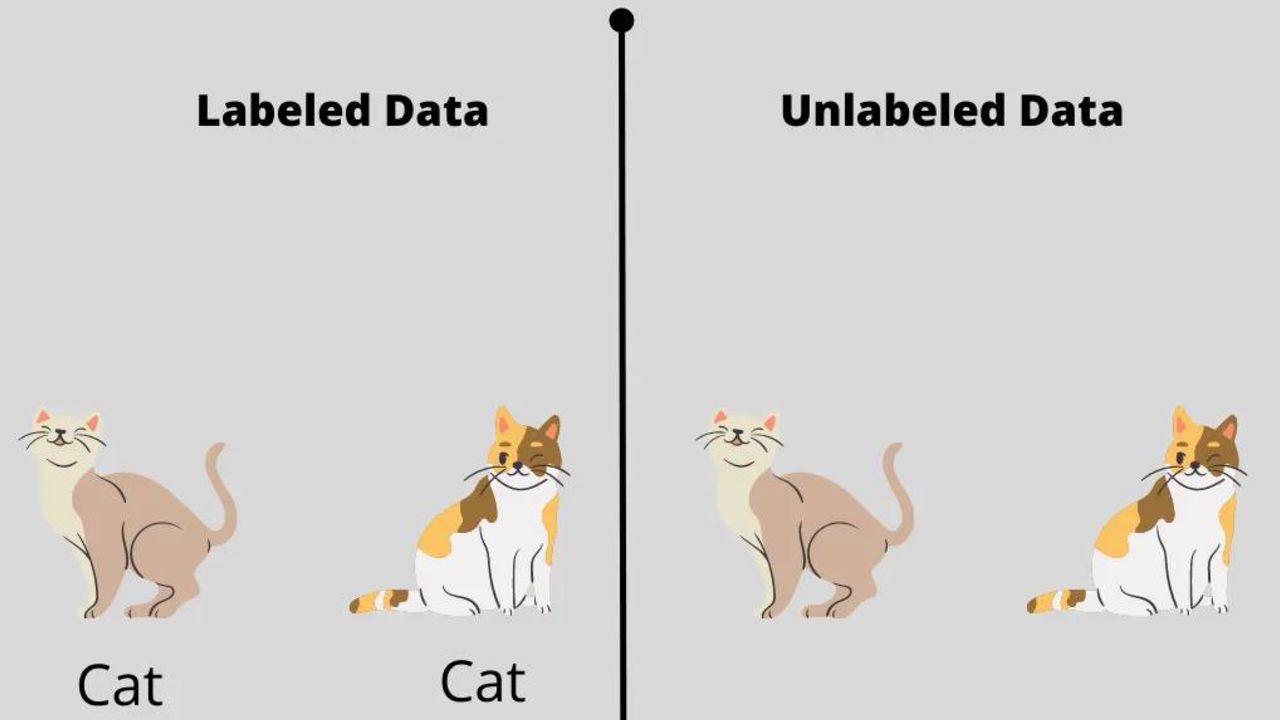
Machine learning is a rapidly growing field that is changing the way we look at data analysis. The two main categories of machine learning are supervised and unsupervised learning. While supervised learning is more widely known and used, unsupervised learning has its own set of unique applications and benefits.
In this blog post, we will explore what unsupervised learning means in machine learning, how it differs from supervised learning, the types, applications, and the challenges faced in unsupervised learning.
Supervised vs. Unsupervised Learning
Before diving into unsupervised learning, let’s first look at supervised learning. Supervised learning is a machine learning technique where the data is labelled. The labelled data is used to train the machine learning algorithm to make predictions on unseen data. The labels provide a clear objective for the algorithm to learn from, and the model’s performance is measured against the accuracy of the labelled data.
Unsupervised learning, on the other hand, is a machine learning technique where the data is not labelled. The objective of unsupervised learning is to analyze and group unlabeled datasets using machine learning methods.
These algorithms identify hidden patterns or data clusters without the assistance of a person. It is the best option for exploratory data analysis, cross-selling tactics, client segmentation, and image identification because of its capacity to find similarities and differences in information.
The primary difference between supervised and unsupervised learning is the presence or absence of labelled data. In supervised learning, labelled data is used to train the algorithm, while in unsupervised learning, there is no labelled data. Additionally, supervised learning is used for prediction, while unsupervised learning is used for exploration.
Supervised learning is used in applications such as image classification, language translation, and speech recognition. In contrast, unsupervised learning is used in applications such as clustering, anomaly detection, and recommendation systems.
Related: Labelled Data vs Unlabelled Data in Machine Learning
Types of Unsupervised Learning
Unsupervised learning can be broken down into two main categories: clustering and association.
Clustering
Clustering is a technique used to group data points that share similar characteristics. It is an exploratory technique used to identify hidden patterns and relationships within the data. Clustering is used in many applications, including marketing segmentation, image analysis, and social network analysis.
Types of Clustering
There are several types of clustering techniques, including k-means clustering, hierarchical clustering, and density-based clustering.
K-means clustering
K-means clustering is a popular clustering algorithm that partitions data points into k clusters, where k is a predetermined number. The algorithm works by randomly selecting k data points as the initial centroids and then iteratively assigning each data point to the nearest centroid. The centroid is then updated based on the mean of the data points assigned to it. The process continues until the centroids no longer change.
Hierarchical clustering
Hierarchical clustering is another popular clustering algorithm that groups data points into a hierarchical tree-like structure. The algorithm works by merging the closest data points until all data points are in a single cluster. The algorithm can be either agglomerative (bottom to top) or divisive (top to bottom).
In agglomerative clustering, each data point starts as a separate cluster and then is iteratively merged with the closest cluster until all data points are in a single cluster. In divisive clustering, all data points start in a single cluster and are iteratively split until each data point is in its cluster.
Density-based clustering
Density-based clustering is a clustering algorithm that groups data points based on their density. The algorithm works by identifying regions of high density and separating them from regions of low density. The algorithm can identify clusters of any shape and size and is robust to noise and outliers.
Applications of Clustering
Clustering has many applications in various fields, including:
- Marketing segmentation: Clustering is used to group customers with similar characteristics to create targeted marketing campaigns.
- Image analysis: Clustering is used to group similar images based on their features and characteristics.
- Social network analysis: Clustering is used to identify communities of users within a social network based on their connections and interactions.
Association
Association is a technique used to identify patterns and relationships between items in a dataset. The goal of association is to identify items that are frequently purchased or used together. Association is commonly used in recommendation systems, market basket analysis, and anomaly detection.
Types of Association
There are several types of association rules, including Apriori, Eclat, and FP-Growth.
Apriori
The Apriori algorithm is a popular algorithm used for association rule mining. The algorithm works by identifying frequent itemsets, or sets of items that appear together in a dataset more often than a predetermined threshold. The algorithm then generates association rules by identifying itemsets that imply the presence of other items.
Eclat
Eclat is another popular algorithm used for association rule mining. The algorithm works by recursively intersecting itemsets until no more frequent itemsets can be found.
FP-Growth
FP-Growth is a relatively new algorithm used for association rule mining. The algorithm works by constructing a frequent pattern tree that compresses the dataset into a set of frequent patterns. The frequent pattern tree is then used to generate association rules.
Applications of Association
Association has many applications in various fields, including:
- Recommendation systems: Association is used to identify items that are frequently purchased or used together to make recommendations to customers.
- Market basket analysis: Association is used to identify items that are frequently purchased together to optimize product placement and increase sales.
- Anomaly detection: Association is used to identify patterns of behavior that deviate from the norm.
Applications of Unsupervised Learning
Machine learning methods are now frequently used to enhance the user experience of products and test systems for quality control. Compared to manual observation, unsupervised learning offers an exploratory way to view data, enabling businesses to find patterns in massive amounts of data more rapidly. Unsupervised learning has several prevalent real-world applications, including:
Clustering with medical data
When it comes to the medical field, a lot of data is typically accessible without any “labels”. Unsupervised learning is emphasized in this field because labeling medical data can be time- and money-consuming, making unsupervised models more suitable than supervised ones. Unsupervised clustering models can therefore be very helpful for picture segmentation, classification, and detection. The clustering algorithm can take as input a large quantity of unlabeled medical data and can spot informational clusters or patterns that would have been challenging for doctors to spot.
For instance, a neurological disease dataset can be used to run an unsupervised learning algorithm to find risk factors for a disease or subgroups that correlate to various phases of the disease’s progression.
Anomaly Detection
Data anomalies of any kind can be located using clustering. For instance, businesses involved in transit and logistics may use anomaly detection to find logistical roadblocks or reveal faulty mechanical components (predictive maintenance). The method can be used by financial institutions to identify fraudulent transactions and act quickly, which can eventually save a lot of money.
Recommendation Engines and Personalized Ads
The model can use unsupervised learning to discover patterns or predictions by using the input of a person’s search and/or purchase history. As a result, businesses can use this kind of model to create targeted ads and effective selling strategies that are unique to a person based on their behavior data.
Unsupervised learning has a wide range of other uses, all of which tend to assist companies in finding patterns in massive amounts of data that human experts couldn’t do well. For instance, Google News and Apple News both use these algorithms to classify articles on the same topics that are received from various news sources.
Challenges of Unsupervised Learning
- Lack of Labelled Data: The biggest challenge in unsupervised learning is the lack of labeled data. Since the algorithm has no guidance, it must rely on finding patterns and structure in the data on its own.
- Difficulty in Evaluation: Since there are no labels to evaluate the performance of the algorithm, it can be challenging to determine whether the algorithm is working correctly or not.
- Overfitting: Unsupervised learning algorithms are prone to overfitting, where the algorithm finds patterns in the noise rather than the underlying structure of the data.
- Scalability: Unsupervised learning algorithms can be computationally expensive and may not scale well to large datasets. This can limit their use in real-world applications.
Conclusion
Unsupervised learning is a powerful machine learning technique that can be used to uncover hidden patterns and relationships in data. Understanding the strengths and weaknesses of unsupervised learning algorithms can help machine learning practitioners select the best technique for their specific use case.
As the amount of available data continues to grow, the use of unsupervised learning techniques will become increasingly important for discovering insights and making informed decisions.
Before you go…
Hey, thank you for reading this blog to the end. I hope it was helpful. Let me tell you a little bit about Nicholas Idoko Technologies. We help businesses and companies build an online presence by developing web, mobile, desktop, and blockchain applications.
We also help aspiring software developers and programmers learn the skills they need to have a successful career. Take your first step to becoming a programming boss by joining our Learn To Code academy today!
Be sure to contact us if you need more information or have any questions! We are readily available.
[E-Books for Sale]
1,500 AI Applications for Next-Level Growth: Unleash the Potential for Wealth and Innovation
Put Your Tech Company on the Map!
Get featured on Nicholas Idoko’s Blog for just $50. Showcase your business, boost credibility, and reach a growing audience eager for tech solutions.
Publish Now$5.38 • 1,500 AI Applications • 228 pages
Are you ready to tap into the power of Artificial Intelligence without the tech jargon and endless guesswork? This definitive e-book unlocks 1,500 real-world AI strategies that can help you.
See All 1,500 AI Applications of this E-Book
750 Lucrative Business Ideas: Your Ultimate Guide to Thriving in the U.S. Market
$49 • 750 Business Ideas • 109 pages
Unlock 750 profitable business ideas to transform your future. Discover the ultimate guide for aspiring entrepreneurs today!
See All 750 Business Ideas of this E-Book
500 Cutting-Edge Tech Startup Ideas for 2024 & 2025: Innovate, Create, Dominate
$19.99 • 500 Tech Startup Ideas • 62 pages
You will get inspired with 500 innovative tech startup ideas for 2024 and 2025, complete with concise descriptions to help you kickstart your entrepreneurial journey in AI, Blockchain, IoT, Fintech, and AR/VR.
We Design & Develop Websites, Android & iOS Apps
Looking to transform your digital presence? We specialize in creating stunning websites and powerful mobile apps for Android and iOS. Let us bring your vision to life with innovative, tailored solutions!
Get Started Today



